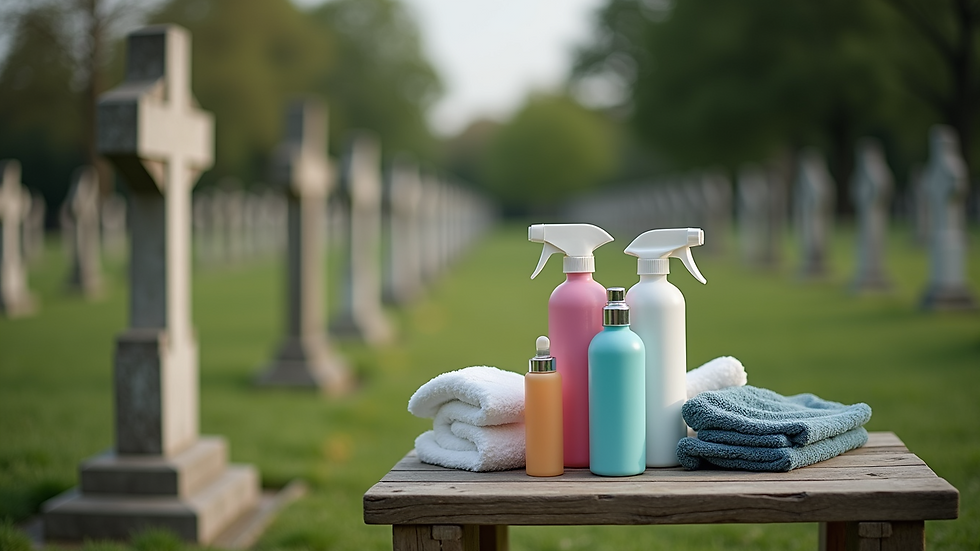Clean Headstones Like a Professional
- Stone Pro
- Sep 5
- 4 min read
Maintaining the dignity and appearance of headstones is a meaningful task. It honors the memory of loved ones and preserves historical markers for future generations. Cleaning gravestones requires care, patience, and the right techniques to avoid damage. I will guide you through the process of cleaning headstones effectively, sharing practical advice and professional insights. Whether you are a family member, a cemetery caretaker, or part of a historical society in South Texas, this guide will help you approach this task with confidence.
Understanding the Importance of Cleaning Gravestones
Cleaning gravestones is more than just an aesthetic effort. Over time, headstones accumulate dirt, moss, lichen, and other biological growths that can obscure inscriptions and degrade the stone. Environmental factors such as rain, wind, and pollution also contribute to wear and discoloration. Regular cleaning helps to:
Preserve the legibility of inscriptions
Prevent long-term damage caused by biological growth
Maintain the respectful appearance of the memorial
Protect the stone from harsh environmental effects
It is important to recognize that different types of stone require different cleaning methods. Common materials include granite, marble, limestone, and sandstone. Each has unique properties and sensitivities. For example, marble is softer and more prone to acid damage, while granite is more durable but can still be scratched by abrasive materials.

Essential Tools and Materials for Cleaning Gravestones
Before starting the cleaning process, gather the appropriate tools and materials. Using the right supplies ensures the stone is cleaned safely and effectively. Here is a list of recommended items:
Soft-bristle brushes: Nylon or natural bristles work well. Avoid wire brushes as they can scratch the stone.
Plastic or wooden scrapers: For gently removing moss or lichen without damaging the surface.
Clean water: Preferably distilled or deionized water to avoid mineral deposits.
Non-ionic detergent: A gentle, pH-neutral cleaner that does not harm the stone.
Spray bottles: For applying water and cleaning solutions evenly.
Buckets: For mixing cleaning solutions and rinsing.
Soft cloths or sponges: For wiping and drying the stone.
Protective gloves: To protect your hands from cleaning agents and debris.
Avoid using bleach, acidic cleaners, or household detergents that contain harsh chemicals. These substances can cause irreversible damage to the stone.

How do professionals clean headstones?
Professional headstone cleaning involves a careful, step-by-step approach that balances thoroughness with preservation. Experts begin by assessing the condition of the stone, identifying the type of material and any existing damage. This evaluation guides the choice of cleaning methods and products.
The typical professional process includes:
Pre-wetting the stone: This prevents the stone from absorbing cleaning solutions too quickly.
Applying a gentle cleaning solution: Usually a non-ionic detergent mixed with water.
Soft brushing: Using soft brushes to remove dirt, algae, and biological growth without scratching.
Rinsing thoroughly: Ensuring no residue remains that could attract dirt or cause staining.
Drying: Allowing the stone to air dry naturally.
In some cases, professionals may use specialized poultices to remove stubborn stains or biological growth. They also avoid high-pressure washing, which can erode the stone surface.
For those interested in seeing examples of expert work, I recommend exploring professional headstone cleaning services that demonstrate these techniques in action.

Step-by-Step Guide to Cleaning Gravestones Yourself
If you decide to clean a gravestone on your own, follow these steps carefully to protect the stone and achieve the best results:
Step 1: Inspect the Stone
Look for cracks, flaking, or loose pieces. If the stone is fragile, avoid cleaning or consult a professional.
Step 2: Remove Loose Debris
Use a soft brush or a gentle blower to clear away leaves, dirt, and loose moss.
Step 3: Wet the Stone
Spray the stone with clean water to saturate it. This helps prevent the cleaning solution from soaking in too deeply.
Step 4: Apply Cleaning Solution
Mix a small amount of non-ionic detergent with water in a bucket. Apply it gently with a soft brush or sponge.
Step 5: Scrub Gently
Work in small sections, scrubbing softly in circular motions. Avoid excessive pressure.
Step 6: Rinse Thoroughly
Use clean water to rinse the stone completely. Residue left behind can cause staining.
Step 7: Dry the Stone
Allow the stone to air dry. Do not use towels or cloths that may leave fibers.
Step 8: Repeat if Necessary
For heavily soiled stones, multiple gentle cleanings may be required over time.
By following these steps, you can maintain the headstone’s appearance without risking damage.
Tips for Long-Term Preservation of Headstones
Cleaning is only one part of preserving gravestones. Consider these additional tips to ensure the memorial remains in good condition:
Regular inspections: Check the stone annually for signs of damage or biological growth.
Avoid harsh chemicals: Never use bleach, ammonia, or acidic cleaners.
Control vegetation: Trim grass and plants around the stone to reduce moisture and root damage.
Report damage: If you notice cracks or instability, contact a professional for repair.
Document condition: Take photos before and after cleaning to track changes over time.
These practices help extend the life of the headstone and maintain its respectful appearance.
Encouragement to Preserve Memories with Care
Cleaning gravestones is a meaningful way to honor those who have passed. It requires patience, respect, and the right techniques. By following the guidance shared here, you can approach this task with confidence and care. Remember, when in doubt, seek advice from experts who specialize in monument restoration.
For those in South Texas looking for trusted assistance, professional headstone cleaning services offer expert care that preserves memorials for generations to come. Together, we can ensure that these important markers continue to stand strong and dignified.





Comments